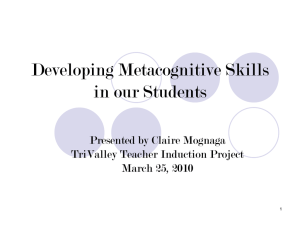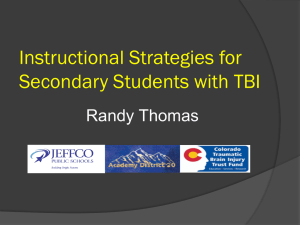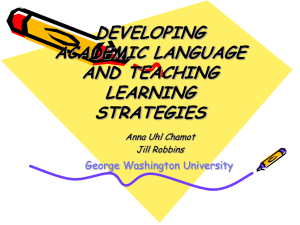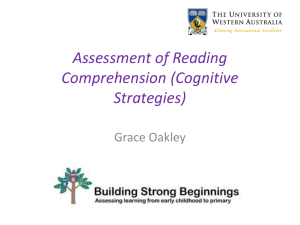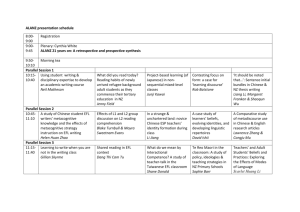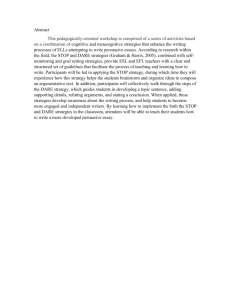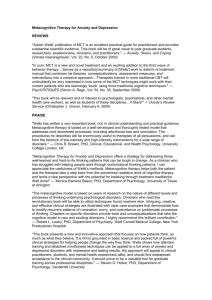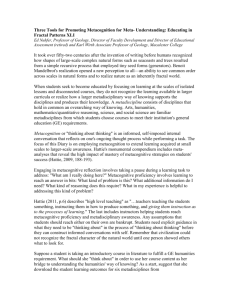Effects of Metacognitive Reading Strategy Instruction on EFL Tenth
advertisement
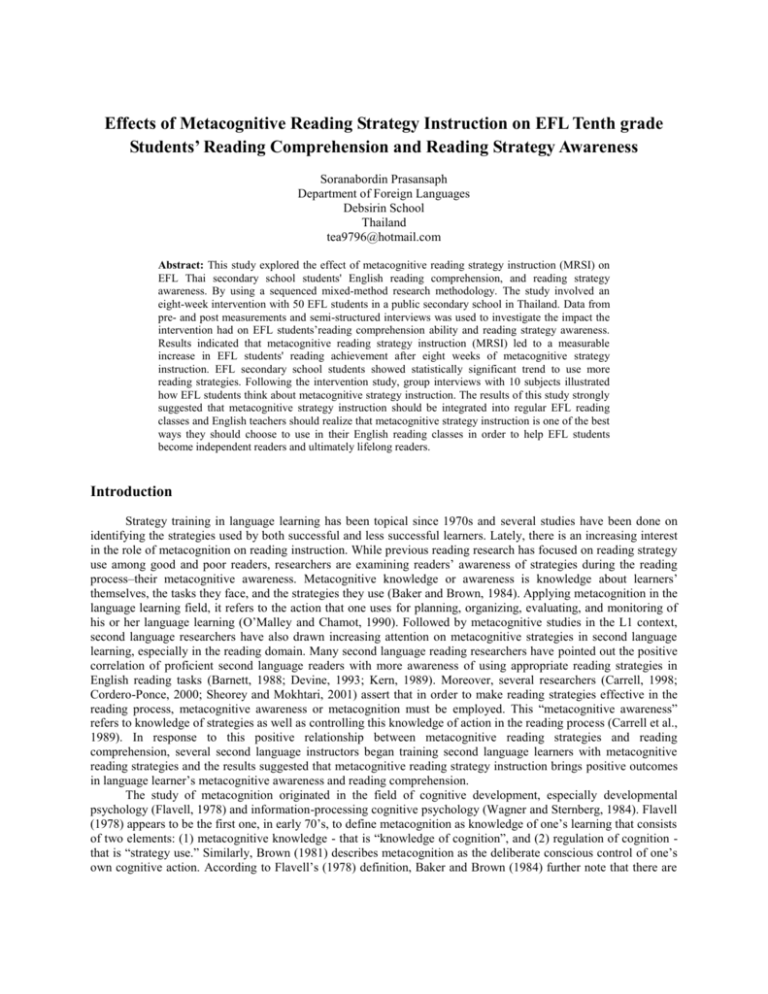
Effects of Metacognitive Reading Strategy Instruction on EFL Tenth grade Students’ Reading Comprehension and Reading Strategy Awareness Soranabordin Prasansaph Department of Foreign Languages Debsirin School Thailand tea9796@hotmail.com Abstract: This study explored the effect of metacognitive reading strategy instruction (MRSI) on EFL Thai secondary school students' English reading comprehension, and reading strategy awareness. By using a sequenced mixed-method research methodology. The study involved an eight-week intervention with 50 EFL students in a public secondary school in Thailand. Data from pre- and post measurements and semi-structured interviews was used to investigate the impact the intervention had on EFL students’reading comprehension ability and reading strategy awareness. Results indicated that metacognitive reading strategy instruction (MRSI) led to a measurable increase in EFL students' reading achievement after eight weeks of metacognitive strategy instruction. EFL secondary school students showed statistically significant trend to use more reading strategies. Following the intervention study, group interviews with 10 subjects illustrated how EFL students think about metacognitive strategy instruction. The results of this study strongly suggested that metacognitive strategy instruction should be integrated into regular EFL reading classes and English teachers should realize that metacognitive strategy instruction is one of the best ways they should choose to use in their English reading classes in order to help EFL students become independent readers and ultimately lifelong readers. Introduction Strategy training in language learning has been topical since 1970s and several studies have been done on identifying the strategies used by both successful and less successful learners. Lately, there is an increasing interest in the role of metacognition on reading instruction. While previous reading research has focused on reading strategy use among good and poor readers, researchers are examining readers’ awareness of strategies during the reading process–their metacognitive awareness. Metacognitive knowledge or awareness is knowledge about learners’ themselves, the tasks they face, and the strategies they use (Baker and Brown, 1984). Applying metacognition in the language learning field, it refers to the action that one uses for planning, organizing, evaluating, and monitoring of his or her language learning (O’Malley and Chamot, 1990). Followed by metacognitive studies in the L1 context, second language researchers have also drawn increasing attention on metacognitive strategies in second language learning, especially in the reading domain. Many second language reading researchers have pointed out the positive correlation of proficient second language readers with more awareness of using appropriate reading strategies in English reading tasks (Barnett, 1988; Devine, 1993; Kern, 1989). Moreover, several researchers (Carrell, 1998; Cordero-Ponce, 2000; Sheorey and Mokhtari, 2001) assert that in order to make reading strategies effective in the reading process, metacognitive awareness or metacognition must be employed. This “metacognitive awareness” refers to knowledge of strategies as well as controlling this knowledge of action in the reading process (Carrell et al., 1989). In response to this positive relationship between metacognitive reading strategies and reading comprehension, several second language instructors began training second language learners with metacognitive reading strategies and the results suggested that metacognitive reading strategy instruction brings positive outcomes in language learner’s metacognitive awareness and reading comprehension. The study of metacognition originated in the field of cognitive development, especially developmental psychology (Flavell, 1978) and information-processing cognitive psychology (Wagner and Sternberg, 1984). Flavell (1978) appears to be the first one, in early 70’s, to define metacognition as knowledge of one’s learning that consists of two elements: (1) metacognitive knowledge - that is “knowledge of cognition”, and (2) regulation of cognition that is “strategy use.” Similarly, Brown (1981) describes metacognition as the deliberate conscious control of one’s own cognitive action. According to Flavell’s (1978) definition, Baker and Brown (1984) further note that there are two types of metacognitive activities: (1) those that concern a person’s knowledge about his or her own cognitive resources and the compatibility between the learner and the learning situation, and (2) those that regulate and modify the process of a cognitive activity. Koda (2005) summarized metacognition as knowledge of recognition which refers to a learner’s understanding and control of his or her own thinking and learning. Effective reading usually involves metacognition. Baker and Brown (1984) suggest that the following strategies are typically used by good readers during the reading process: adjusting reading rate, skimming, or being aware of and revision the materials. To be specific, metacognitive reading strategies refer to procedures that one uses for monitoring his or her own reading processes including evaluating the effectiveness of cognitive strategies being used in reading. Reading strategies are important for EFL students because the limited opportunities in accessing English make English reading strategies equally important to EFL students, English written materials become major resources and language input for them to learn and acquire English. Reading is a valuable source of language input for language acquisition (Bernhardt, 1993). Thus, reading strategies should be emphasized in the initial stages of language learning. EFL students need to know or learn how to read with ease in order to be motivated to read more English materials in order to build up their English ability. Thai government has made English education a priority to enhance Thai’s economic competition. For a long time, the Thai government declared that English instruction would be extended beginning in the 1st grade instead of the 6th grade as of 2001. However, receiving English instruction five years earlier doesn’t guarantee for successful language learning, what is important is that EFL students should be taught how to learn English strategically. Inability to read English effectively has not only caused Thai students to experience barriers to academic success, but has also disadvantaged them in their career performance or in gaining access to the latest trend of ASIAN community. There is evidence showing that reading strategies were not widely taught in high schools or middle schools in Thailand and EFL students were hoping that reading strategy should have been taught to them. Therefore, how to assist EFL students in taking control of their own reading process while fostering success and positive attitudes toward EFL reading has become one of the most urgent tasks facing educators who teach English throughout Thailand. The purpose of this study is to investigate the effectiveness of integrating metacognitive reading strategy instruction (MRSI) to EFL secondary school students on their reading comprehension and reading strategies awareness. The Study Three research questions of this study are as following. The first two research questions are used to guide the quantitative part of the study while the last research question is used for the qualitative part of the study. (1) Does metacognitive reading strategy training affect EFL secondary school students’ reading comprehension and reading strategy awareness?( 2) Does metacognitive reading strategy training enhance EFL secondary school students to use more reading strategies? and (3) What are the EFL secondary school students’ opinions to the metacognitive reading strategy instruction? For this study, the research hypotheses are “H01: after the metacognitive reading strategy instruction, the students’ reading comprehension mean score of the post-test is significantly higher than that of the pre-test” and “H02: after the metacognitive reading strategy instruction, the students significantly use more reading strategies.” A one group pretest-posttest design with an experimental explanatory study using a mixed methods approach was conducted for data collection and to quantitatively and qualitatively examine the effect of MRSI on EFL students’ reading experience by integrating MRSI into English reading class at Debsirin School. A sequential mixed method approach was used to better understand the whole impact of MRSI by first quantitatively conducts the experiment and later qualitatively explain the real life context in which is occurred. I intended to not only establish the pre and post SORS measures. The sequential method enables me to conduct quantitative data first and follow-up qualitative interview and later integrate the information when interpreting the overall results. The preliminary assumption was that MRSI would help improve EFL secondary students’ reading comprehension, and reading strategy awareness. Participants were 50 tenth grade students at Debsirin School, a public secondary school located in Bangkok, in the center of Thailand. Among these students, all were boy students at the age of 15-16. They alternatively came to the classroom gave a lot of cooperation when metacognitive strategy training was conducted for 8 weeks. Three instruments were used in this study, (1) a 60 item multiple-choice test of reading comprehension, which was developed by the researcher, (2) the Survey of Reading Strategies (SORS), a questionnaire used to test students’ metacognitive reading strategies awareness, adapted by Mokhtari and Sheorey (2001) and (3) a semi-structured interview questions conducted by the researcher. The independent variable in this study is metacognitive reading strategy instruction. The dependent variables in this study are the scores of the post-SORS, and the post reading comprehension test scores. The dependent t-test analysis was used to test hypotheses from H01 to H03 with the pretest score and the post score of the SORS, and reading comprehension score as the dependent variables. Qualitative data was collected from ten students participated in semi-structured open-ended interview conducted by the research. The interview questions were written out in advance exactly the way they were to be asked during the interview and themes were determined and reported in a descriptive format. The interview was audio taped and transcribed into English for further analysis. The data were analyzed by content analysis. Findings In order to see the efficacy of the intervention, students’ pre- and post test scores of reading comprehension tests were analyzed to examine if there was a statistically significant difference between pre-test and post-test. The results in Table 1 indicate that the overall average of post-test was much higher than the pre-test. And the dependent t-test analysis shows a statistically significant difference between the two tests at the level of .05. Table 1: Students’ Pre- and Post-test of Reading Comprehension Scores X S.D. n Pre-test 33.12 5.93 50 Post-test 43.56 7.34 50 t-value Sig. 14.58 .000 p.05 For using the reading strategies, the results show that the overall average of metacognitive reading strategies use of the students before the intervention training was 3.14 and improved up to 3.50. After the instruction the students tend to use metacognitive reading strategies more often than before training, with the different level of interpretation (using them at the high level). The results also show that three strategies with the highest mean scores after the instruction included (17) I use context clues to help me better understand what I am reading, (28) When I read, I guess the meaning of unknown words or phrases and (14) When text becomes difficult, I pay closer attention to what I am reading. The averages are 4.12, 3.94 and 3.86 respectively, while the lowest mean score was (21) I critically analyze and evaluate the information presented in the text with average 2.94. Summary of the results was shown in Table 2. Table 2: Pre- and Post- Scores of Students’ Metacognitive Reading Strategies Metacognitive Reading Strategies 1. I have a purpose in mind when I read. 2. I take notes while reading to help me understand what I read. 3. I think about what I know to help me understand what I read. 4. I take an overall view of the text to see what it is about before reading it. Pretest Posttest X S.D. X S.D. 2.98 2.94 2.82 1.35 1.29 1.24 3.76 3.38 3.44 0.93 1.04 0.90 3.14 1.11 3.54 1.14 Table 2: Pre- and Post- Scores of Students’ Metacognitive Reading Strategies (cont.) Metacognitive Reading Strategies 5. When text becomes difficult, I read aloud to help me understand what I read. 6. I think about whether the content of the text fits my reading purpose. 7. I read slowly and carefully to make sure I understand what I am reading. 8. I review the text first by noting its characteristics like length and organization. 9. I try to get back on track when I lose concentration. 10. I underline or circle information in the text to help me remember it. 11. I adjust my reading speed according to what I am reading. 12. When reading, I decide what to read closely and what to ignore. 13. I use reference materials (e.g. a dictionary) to help me understand what I read. 14. When text becomes difficult, I pay closer attention to what I am reading. 15. I use tables, figures, and pictures in text to increase my understanding. 16. I stop from time to time and think about what I am reading. 17. I use context clues to help me better understand what I am reading. 18. I paraphrase (restate ideas in my own words) to better understand what I read. 19. I try to picture or visualize information to help remember what I read. 20. I use typographical features like bold face and italics to identify key information. 21. I critically analyze and evaluate the information presented in the text. 22. I go back and forth in the text to find relationships among ideas in it. 23. I check my understanding when I come across new information. 24. I try to guess what the content of the text is about when I read. 25. When text becomes difficult, I re-read it to increase my understanding. 26. I ask myself questions I like to have answered in the text. 27. I check to see if my guesses about the text are right or wrong. 28. When I read, I guess the meaning of unknown words or phrases. 29. When reading, I translate from English into my native language. 30. When reading, I think about information in both English and my mother tongue. Total Pretest Posttest X S.D. X S.D. 2.86 2.88 1.20 1.32 3.34 3.22 1.12 1.15 3.16 1.25 3.56 1.08 3.14 3.06 3.20 3.22 2.62 1.37 1.41 1.18 1.14 1.34 3.40 3.48 3.78 3.72 3.54 1.13 1.25 1.03 0.98 0.96 3.56 1.12 3.08 1.35 3.46 3.26 3.34 3.60 1.08 1.07 1.23 1.06 3.86 3.68 3.54 4.12 0.94 1.03 1.10 0.77 2.68 3.06 1.36 1.21 3.02 3.66 1.36 1.07 3.56 1.13 3.56 1.30 2.28 3.04 3.10 3.50 3.54 3.30 3.02 3.68 2.94 1.10 1.18 1.27 1.08 1.04 0.98 1.35 0.99 1.42 2.94 3.28 3.10 3.50 3.70 3.24 3.50 3.94 3.56 1.14 1.22 1.27 1.08 1.04 1.07 1.08 0.79 1.17 3.38 3.14 1.06 1.25 3.48 3.50 0.98 1.12 Students’ reading strategies awareness was assessed through their responses on the Survey of Reading Strategies (Mokhtari and Sheorey, 2002) before and after the treatment. As shown in Table 2, the mean score of pretest for the SORS for the entire sample was 3.14 with a standard deviation of 1.25. Overall, the participants’ reading strategy awareness on the pre-test ranged from 2.28 to 3.68 with a mean score of 3.14, while the post-test ranged from 2.94 to 4.12 with a mean score of 3.50. In order to find out whether the students’ overall average of metacognitive reading strategies use increased significantly after the instruction, the pre-and post scores were analyzed as shown in Table 3. Table 3: Pre- and Post- Metacognitive Reading Strategies from the Survey questionnaire SORS X S.D. n t-value Sig. 3.14 1.25 50 5.26 .000 3.50 1.12 50 Pre-Meta. Strategies use Post- Meta. Strategies use p.05 The results in Table 3 indicate that mean score or average of the post-metacognitive reading strategies was obviously higher than mean scores of the pre-metacognitive reading strategies. The dependent t-test analysis shows a statistically significant difference between the pre-and post-metacognitive reading strategies at the level of .05. That means the students turned to use more metacognitive reading strategies after training. The qualitative analysis from the semi-structured interview reveals that participants thought that metacognitive strategies were very useful and helped them read passages or texts more effectively. And also helped them interact with other members or friends while doing activities. Moreover, the participants were sure that these strategies helped them be more careful and became more confident to use reading strategies while they were reading. Conclusions An explicit instruction of metacognitive reading strategies influenced students’ reading comprehension and reading awareness. In addition to measureable gains on their pre/post reading comprehension assessment, EFL students in this study were able to show the evidence of their increasing metacognitive strategy awareness as the study went on. In two months of metacognitive reading strategy instruction, this study demonstrated a statistical difference in reading comprehension of most EFL secondary students, regardless of their L2 language proficiency. This study provided evidence that metacognitive reading strategy instruction, which has been proven effective for L1 students, can also improve EFL students’ reading comprehension. The prominent feature of this study is that while most studies on metacognitive reading strategy instruction measure the success of ESL/EFL students’ reading comprehension solely by quantitative reports, this one has tried to balance the statistical findings with the qualitative explanations of how students thought about metacognitive reading strategy instruction. Nowadays, English teachers in Thailand are under great pressure in terms of preparing their EFL students for the yearly entrance examinations. Some may argue that they don’t have the luxury to spend time teaching their students how to self-direct learn and read. In order to meet school and parents’ expectations, most of them are diligent teachers, trying to teach whatever they know and to cover whatever their EFL students needs to know in order to perform well in the exams. They felt it would be more useful to teach their EFL students test-taking strategies, which are different from reading comprehension strategies for effective understanding or mean-making. The reason behind this problem is now clear if EFL students are not taught how to be independent learners, dependence on English teachers’ instruction can hardly allow them to reach a satisfactory level. This study, by integrating metacognitive reading strategy instruction into a regular EFL English class, provides evidence that effective metacognitive reading strategy program can improve EFL adolescent students’ English reading achievement. References Alderson, J.C. (2000). Assessing reading. Cambridge, UK: Cambridge University. Almasi, J.F. (2003). Teaching strategic processes in reading. New York: Guilford Press. Anderson, N.J. (2002). The role of metacongition in second language teaching and learning. ERIC Digest, April, 2002, 3-4. Autrey, J. H. (1999). Effects of direct instruction and precision teaching on achievement and persistence of adult learners. Dissertation Abstracts International, 60 (06),1863A. (UMI No. 9932955) Baker, L (2002). Metacognition in comprehension instruction. In C. C. Block & M. Pressley (Eds.), Comprehension Instruction: Research based best practices, pp.77-95, New York: Guilford. Baker, L., & Brown, A. L. (1984). Metacognitive skills and reading. In P. D. Pearson, M. Kamil, R. Barr, & P. Mosenthal (Eds.), Handbook of reading research 1, pp. 353-394, New York, NY: Longman. Barbe-Clevett, T., Hanley, N., & Sullivan, P. (2002). Improving reading comprehension through metacognitive reflection. (ERIC Document Reproduction Service No.ED471067) Barnett, M. A. (1988). Reading through context: How real and perceived strategies use affects L2 comprehension. Modern Language Journal, 72, pp.150-162. Bernhardt, E.B. (1993). Reading development in a second language. Norwood, NJ: Ablex. Block, E. (1986). The Comprehension strategies of second language readers. TESOL Quarterly, 20, pp.463-494. Brown, A. (1981). Metacognitive development and reading. In Spiro, R., Bruce, B. & Brewer, W. (Eds.), Theoretical issues in reading comprehension. Hillsdale,:Lawrence Erlbaum Associates. Carrell, P. L. (1998). Metacognitive awareness and second language reading. Modern Language Journal, pp.73, 120-134. Carrell, P. L., Pharis, B. G., & Liberto, J. C. (1989). Metacognitive strategy training for ESL reading. TESOL Quarterly, 23,pp. 647-678. Cordero-Ponce, W.L. (2000). Summarization instruction on foreign language comprehension, Reading Research and Instruction, 39 (4), pp.329-350. Devine, J. (1993). The role of metacognition in second language reading and writing. In G. Joan and L. I. Carson (Eds.), Reading in the composition classroom, second language perspective (pp. 105-130). Boston: Heinle and Heinle Publishers. Eilers, L., & Pinkley, C. (2006). Metacognitive strategies help student to comprehend all text. Reading Improvement, 43(1), pp.13-29. Flavell, J. H. (1978). Metacognitive development. In J. M. Scandura & C. J. Brainerd (Eds.), Structural/process theories of complex human behavior (pp. 213-245). Alphen aan den Rijn, the Netherlands: Sijthoff and Noordhoff. Farrell, T.S.C. (2001). Teaching reading strategies: “It takes time!” Reading in a Foreign Language, 13 (2), pp.631646. Flavell, J. (1979). Metacognition and cognitive monitoring: A new area of cognitive-developmental inquiry. American Psychologist, 34, 906-911. (pp. 21-29). Hillsdale, NJ: Lawrence Erlbaum. Garner, R. (1987). Metacognition and reading comprehension. Norwood, NJ: Ablex Publishing. Garner, R., & Alexander, P. (1989). Metacognition: Answered and unanswered questions. Educational Psychologist, 24(2), pp.143-158. Goodman, K. (1976). Reading: A psycholinguistic guessing game. Journal of the Reading Specialist, 6, pp.126-135. Grabe, W. (2004). Research on teaching reading. Annual Review of applied Linguistics, 24, pp. 44-69. Grabe, W., & Stoller, F.L. (2002). Research on teaching reading. Annual Review of Applied Linguistics, 24, pp.4469. Kern, R. (1989). Second language reading strategy instruction: its effects on comprehension and word inference ability, Modern Language Journal, 73, pp. 135-149. Koda, K. (2005). Insights into second language reading: A cross-linguistic approach. Cambridge: Cambridge University Press. Brown, A.L., Campione, J.C., & Day, J.D. (1981). Learning to learn: On training students to learn from texts. Educational Researcher, 10, 2, (pp.14-21). O'Malley, M. & Chamot, A. (1990). Learning strategies in second language acquisition. New York: Cambridge University Press. Oxford, R. L. (1990). Language learning strategies: What every teacher should know. Boston, MA: Heinle & Heinle Publishers. Paris, S. G., & Oka, E. (1986). Children’s reading strategies, metacognition, and motivation. Developmental Review, 6, 25-26. Pressley, M. (2000). What should comprehension instruction be the instruction of? In M. L.Kamli, P.B. Mosenthal, P.D. Pearson, & R. Barr (eds.) Handbook of Reading Research, Vol. III. Lawrence Erlbaum Associates, Publishers Mahwah, New Jersey. Sheorey, R., & Mokhtari., K. (2001). Differences in the metacognitive awareness of reading strategies among native and non-native readers. System, 29, 431-449. Wagner, R.K. and Sternberg, R.J. (1984). Alternative conceptions of intelligence and their implications for education. Review of Educational Research, 54 (2): 179–223. Zhang, L. J. (2001). Awareness in reading: EFL students’ metacognitive knowledge of reading strategies in an acquisition-poor environment. Language Awareness, 10 (4), 268-288.

